The City Where Life Happens Underground
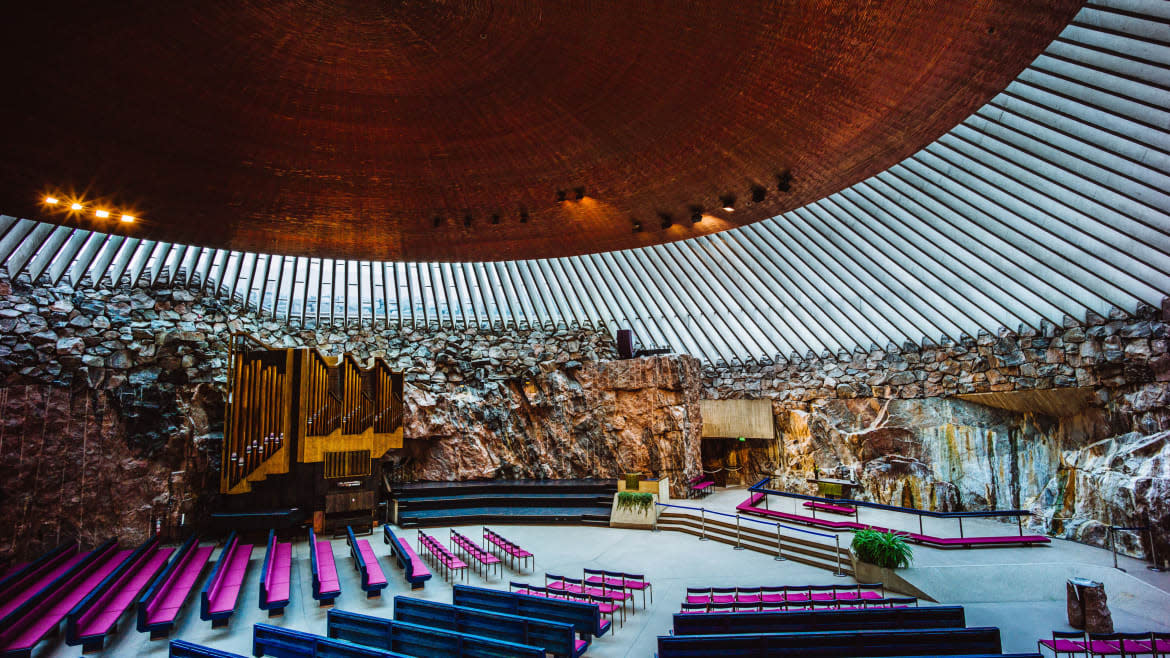
One of my best friends grew up attending weekly swim lessons in a bunker in Helsinki. While an interesting story to trot out at dinner parties, her personal fun fact seemed wildly disconnected from the Helsinki I’ve come to know.
The Finnish capital has always prided itself on its connection to nature. Built on an archipelago, there’s plenty to go around. Whether it’s the ocean, parks, or a combination of the two in the Töölö district, residents are never more than a few minutes away from literally touching grass.
And while Nordic summers give way to intense winters, newer constructions, like the Helsinki Central Library and surrounding buildings in Kansalaistori square feature oversized windows—helpful whether letting in Nordic sun or views of snow flurries. Sure, swimming underground might be unusual, but so is the Allas Sea Pool, a recreation center that literally overlooks the Helsinki Presidential Palace.
But what I had missed across multiple visits was just how much of life takes place underground. Just below the surface, Helsinki has more than 5,500 bunkers, enough to hold its entire population of over 1.3 million people. The prevailing reason? Russia.
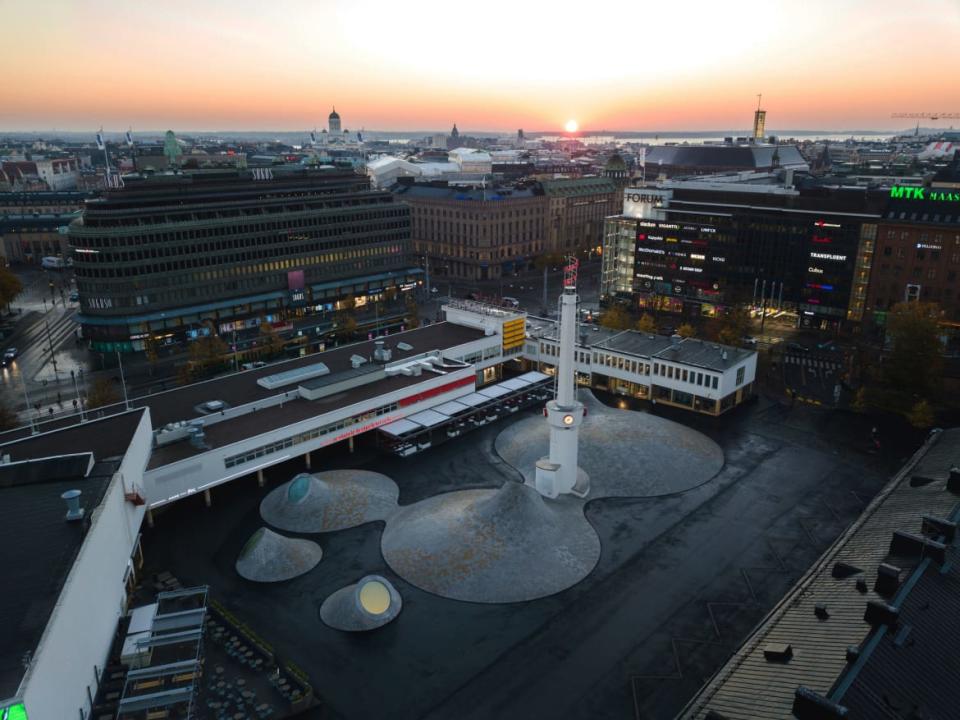
An aerial photo of the Glass Palace courtyard in Helsinki, Finland.
Some quick history—it isn’t just the Cold War that’s increased tensions. From 1809 to 1917, when it secured its freedom, Finland was part of the Russian Empire. When Russian troops tried to reclaim territory in 1939, they were summarily driven out in less than four months. And while Finnish cybersecurity and surveillance is strong enough for the country to ignore blatant attempts at propaganda, it’s the intimate knowledge of the neighbor to east, which shares an 833-mile border, that translates to mandatory conscription for men, ages 18-60, and for all buildings over 1,200 square meters to have a designated bomb shelter. It’s no accident that the UNESCO heritage site the Island of Suomenlinna is known for its fortifications. This is a slow burn struggle that Finns are familiar with.
Due to a misprint in the Atlas Obscura, there’s a rumor that Helsinki’s complex system of bunkers is all interconnected—bringing to mind some retro-futuristic subterranean city. (Despite having 300 kilometers of tunnels one cannot actually mole-person from one side of the metro area to the other.) However, the long tale of how being forced to fortify the city has affected it is far more interesting than the myth.
Traditionally, Finnish design has translated to functional, streamlined buildings, partially inspired by the country’s Swedish and Russian neighbors. But it’s Finnish designer Alvar Aalto, and his belief in human-centered building design, that casts the longest shadow over Helsinki’s underground spaces. Whether their true intent is immediately obvious, these constructions are regularly used. We visited a few and found that they collectively create fascinating views of how the city has merged practicality and culture.
The Holy
Temppeliaukio Church, which receives over 500,000 visitors per year, stands out as a tourist spot thanks to its stunning underground chapel. The space features a two-story organ and rocky walls, lit in a heavenly glow from a series of rooftop windows. To step in is to be surrounded by earth. Storage spaces lead into dead-end rock walls. Windows are washed by the annual snowpack, and the interior rock wall is cleaned by the rain water that regularly seeps through. It is, as Heli Suhtala Uvalic, a customer service manager, notes, the most accidentally earth-friendly building in the city.
While the designers Timo and Tuomo Suomalainen’s reasons for designing the subterranean church have been lost to time, the brothers had previously worked for the Finnish defense forces, building defense caves. Strong, sturdy spaces were on their minds, a forward-thinking approach that got them the job.
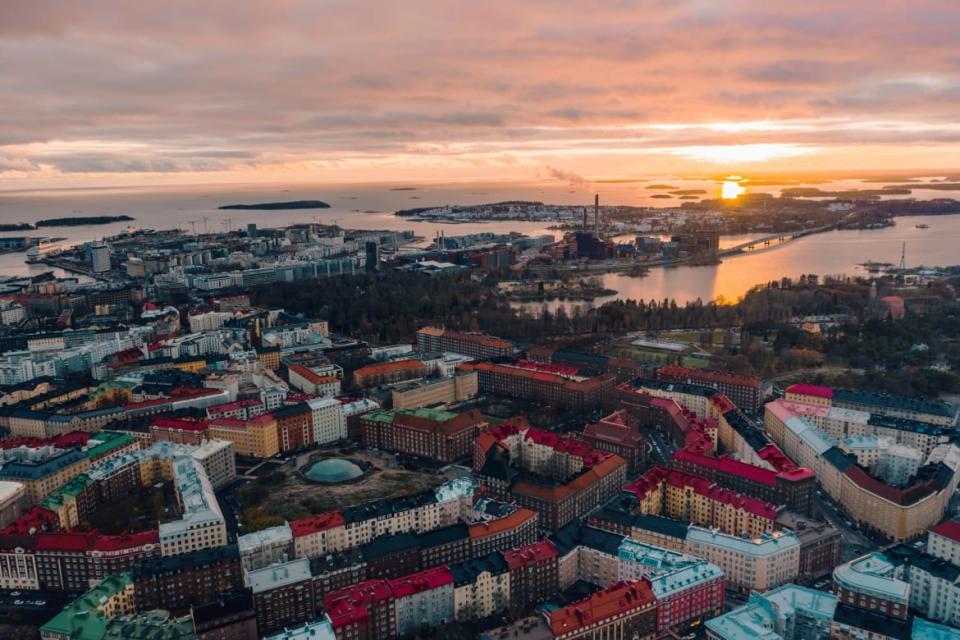
An aerial shot of the Töölö district and the Temppeliaukio Rock church in Helsinki.
“They have been planning since the early 20th century to build a church on this site,” says Uvalic. “That’s why they named it Temple Square in the city plan. They had the first design competition in the early ’30s. And they had another one in the late ’30s, before the war. But then the war made it come to a stop. And then they waited till the early ’60s, they had yet another competition, because they thought the cathedral was maybe a little old-fashioned by them. That’s when the Suomalainen brothers came up with this idea.”
She leads us into the underground break rooms where, despite the normal appearance of walls, the air pressure is a constant reminder that you are indeed still surrounded by rock. This is where the building meets its legal requirements as a bunker, but Uvalic is prepared to show us something more interesting than where the staff takes coffee breaks. In the rock-lined service tunnel beyond, the word “Biafra” is sprawled in large paint letters. It’s one of 15 incidents of graffiti discovered during the building process, a protest left by local students who felt resources would have been better given to West Africa than used for a local cathedral. A small piece of history, the only one left, preserved in the Helsinki underground.
The Creative
Opened in 2018, Amos Rex was an immediate hit with art fans. Built two years after the city rejected a $138 million offer from Guggenheim, the $58 million museum became a prime example of local investment. Its reputation was bolstered by a colorful slate of shows that included the crowd-pleasing Japanese tech collective teamLab, and an exhibition focused on humans’ relationship to the underground, a theme that stretched from natural resources, to the mythological, literary, and physiological aspects. (Kai Kartio, Museum Director Amos Rex calls the somewhat difficult exhibition a surprise hit among guests.)
Sandwiched between Helsinki’s Central Railway Station and the nearby Kamppi shopping center, the gallery is easy to access, a neon-marked location that has attracted over 500,000 visitors every year since it opened. But to fully understand Amos Rex, you have to start underground—specifically with the five submarine-like windows peeking up Lasipalatsi Square, creating a Wes Anderson-worthy playground structure for both art fans and local teenagers. As Kartio explains, going underground to create their show space was a no-brainer when they took over the entertainment complex in 2012. Called Lasipalatsi (“glass palace”), the building was a prime example of 1930s Finnish modernist architecture—which meant it was also heavily protected. Expanding into an underground annex 20 feet underground was the brainchild of Asmo Jaaksi, the leading architect at JKMM.
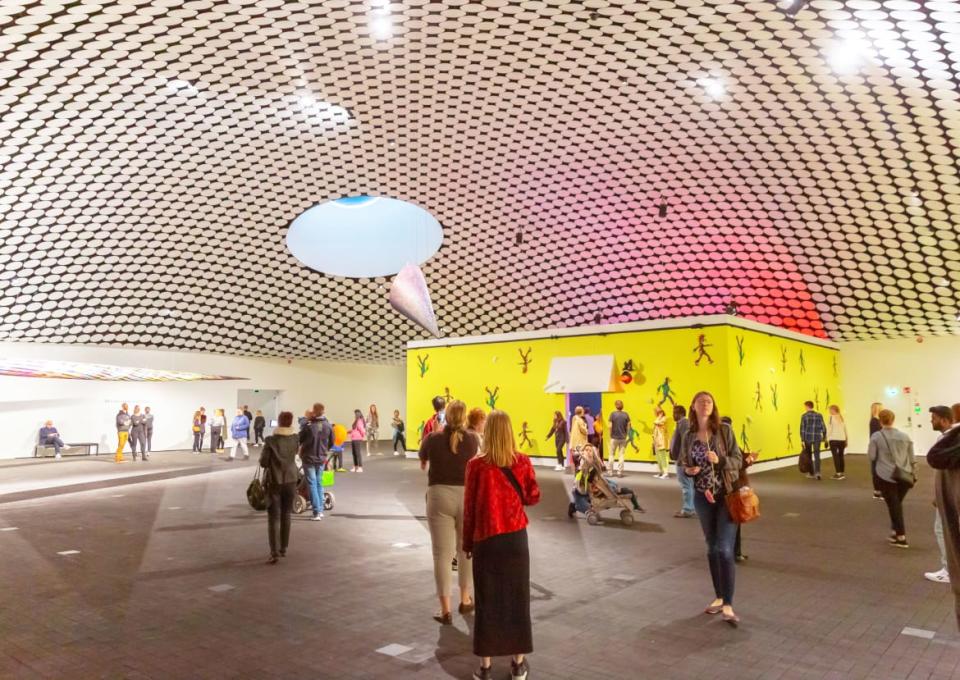
The Amos Rex museum in Helsinki, Finland.
“It wasn’t possible to convert this old building without spoiling it,” says Kartio. “It’s really protected, and it’s good that it’s protected. What we wanted was a very flexible exhibition space with as few limiting, fixed walls as possible… what we wanted of our underground exhibition space was that it would be sort of architecturally interesting, that it would have a kind of visual identity, and that it would be very flexible and possible to convert this into a space for all kinds of different exhibitions. But then we also wanted to keep the feeling that, ‘OK, you go underground but it doesn’t really feel like going into a dark basement.’”
Entering the lobby, with its curly white-paper ceilings may feel like Finnish functionalism has been left behind. But true to Kartio’s word, the space is a playful take on practicality. High ceilings give the gallery an expansive quality beyond its 2,200-square-meter floor space. And ceiling disks alter the room’s acoustics—although taking the room from light to dark in the name of attention to detail can be a time-consuming process.
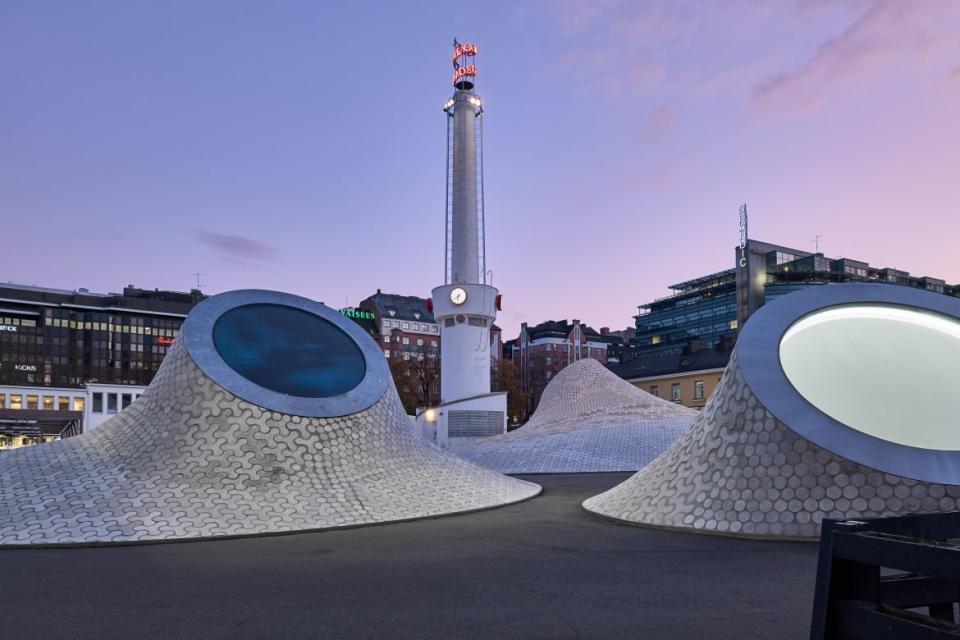
Glass Palace courtyard on the roof of the Amos Rex Art Museum in Helsinki, Finland.
“The idea of the architect was that they would have kind of hats on a kind of white fabric, which also would make the acoustics a little bit softer,” says Kartio. “So, every other exhibition, we have the covers on and every other time we take them off, it's a big job. There are lots and lots and lots of those, that it changes completely the aspect of the space.”
The Leisure Set
While Temppeliaukio and Amos Rex were both created as underground spaces that can be used as bunkers in a pinch, there’s a whole other subset of buildings in Helsinki that started as bunkers, only to become backwards compatible with daily life. A byproduct of a city determined to combat both urban sprawl and brutal winter weather.
Itäkeskus swimming hall, where my friend learned how to do a creditable backstroke, is a kitschy delight. Built in 1993 there’s still a touch of nostalgia to the humid hall, from the tropical-themed cartoons covering the walls of the children’s section, to the colorful flags crisscrossing the ceilings. But designed by Hkp Architects, the area was envisioned to play well with its intended purpose. During swimming hours, it can host 1,000—but in case of emergency pools can be drained within a day, and 3,800 people can take shelter under its 15 meters of granite. One of the city’s more elaborate shelters, it also features blast doors, an air filtration system, and even pressure valves. While components are regularly tested, it has never been used.
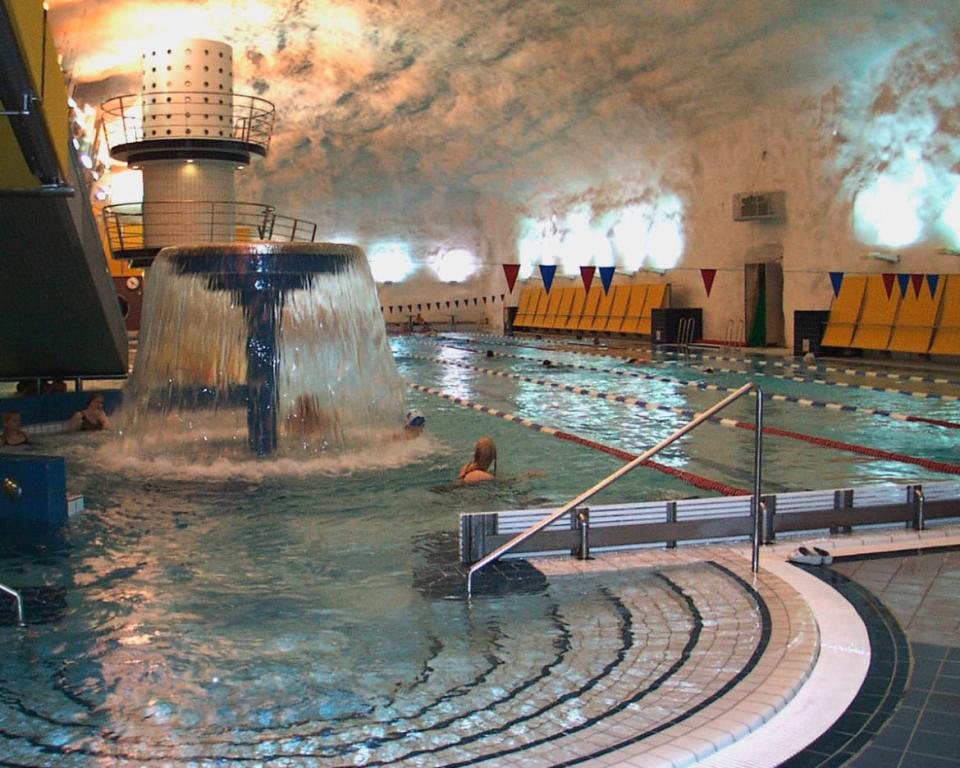
Inside the Itäkeskus swimming hall in Helsinki, Finland.
The same philosophy prevails at The Formula Center. A short walk through the Eastern Helsinki woods from Itäkeskus, Formula Center is Helsinki’s only go-kart track, and—to their knowledge—the only underground go-kart track in the world. Racers cross a course through a cave, living out their Mario Kart fantasies under purple and green lights. The 300-meter-long track has been praised for its speed, but it’s a notably claustrophobic space—once you cross the heavy blast doors at the entrance, there’s no mistaking the cave’s original intent. Built in 1970, it wasn’t until 1995 that Formula Center moved in, taking the space over from a former furniture warehouse. It seems small, but the space that can host 30 drivers can also protect two and a half thousand people in a worst-case scenario. The logistics of how that’s meant to work, is left up to the powers that be—specifically the Helsinki Fire Brigade which owns the shelter.
“If they push the button, we have 72 hours to take our stuff out,” explains company owner Lauri Illukka. “We don't have so much stuff. Many times, we talk about it. And this is maybe the safest place to be.”
With that, he shrugs and offers the opportunity to take a car out on the track. The message is clear—just because they have the ability to retain a level of functionality in case of emergency doesn't mean they’re prepared to let the possibility of disaster interfere with daily life. You’ve got to live, and designing your life with humans, rather than ‘what-ifs’ the forefront is far more satisfying. Maybe the prevailing advice, “just look up” isn’t always enough. Sometimes, to truly understand a city, you’ve got to dig.
Get the Daily Beast's biggest scoops and scandals delivered right to your inbox. Sign up now.
Stay informed and gain unlimited access to the Daily Beast's unmatched reporting. Subscribe now.

